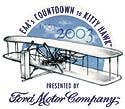
In a letter to George Spratt in June, 1903, Orville Wright gave their friend a progress report on propeller design for the Flyer … and closed with a prophetic postscript. "Please do not mention the fact of our building a powered machine to anybody," he warned. "The newspapers would take great delight in following us to record our troubles."
Looking back nearly a century later, it is easy to assume that the Wrights' historic first powered flight on December 17, 1903, was inevitable. After all, they had done their homework and it was bound to happen. In fact, all that fall the brothers were beset by problems that almost overpowered them, but to their credit they never ceased to persevere … and so won the final prize.
Their first day at Kitty Hawk was marvelous-75 glides in the '02 glider, the best of which, 30.4 seconds in length, broke their old record. Quickly, they set about repairing their old building, which had been blown off its foundation during the winter, and constructing a new 44 by 16 foot shed in which to store the glider and their Flyer. Then their luck turned sour.
|| |---| | | | The completed Flyer beside the camp sheds.| On October 15th, the first of a succession of storms hit the Outer Banks, repeatedly damaging their buildings and causing a lake to circle their camp. The mosquitoes returned so thick that, as Orville wrote, "They turned day into night." When it was not raining, there was punishing heat. Through it all, the Wrights continued to work on their Flyer_- first completing construction of the frame, then placing the engine and propellers into the craft. On November 5th, the _Flyer was ready for ground testing, but disaster struck. The engine sprockets could not be tightened; the magneto failed to provide a sufficient spark; vibrations from the engine damaged the propeller shafts. Disheartened, they sent the shafts back to Dayton, so Charlie Taylor could repair them.
Worse yet, when they had first weighed their Flyer, its weight had exceeded their estimate by 70 pounds. To achieve flying speed, the Wrights calculated that the propellers would have to deliver another 10 pounds of thrust. It scarcely seemed possible. On November 20th, the new shafts finally arrived, but in the first test, the magneto again failed to spark, and they could not get the sprockets to stay tight on the propeller shafts. Noted Orville in his diary, "Day closes in deep gloom."
The next day, however, things began to go their way. A liberal dose of tire cement solved the sprocket problem, the magneto problem was solved by an adjustment to the gasoline feed valve, which allowed the engine and propellers to produce an additional 16 to 18 pounds of thrust, more than they had thought possible. "Our confidence in the success of the machine," Orville recorded in his diary, "is now greater than ever before."
A week later, however, disaster struck again. While testing the engine, one of the propeller shafts cracked. Orville left immediately for Dayton, to make new shafts of solid tool steel. Until he returned on December 11th, there was nothing for Wilbur to do but wait and worry.
This "Kitty Hawk Moment" is brought to you by the EAA, whose Countdown to Kitty Hawk program, presented by Ford Motor Company, includes an exact flying reproduction of the Wright Flyer. It is the centerpiece of the EAA's national tour during 2003, which will conclude with a five-day celebration at Kitty Hawk, North Carolina, where the Wright Flyer will fly again at exactly 10:35 a.m. on December 17, 2003, commemorating 100 years of powered flight.

Sign-up for newsletters & special offers!
Get the latest FLYING stories & special offers delivered directly to your inbox






